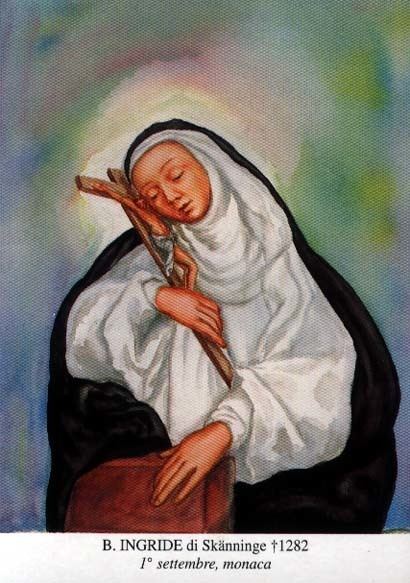 | ||
Saint Ingrid of Skänninge (died in Skänninge, 9 September 1282) was a Swedish Roman Catholic saint. She founded the convent of the Dominican order for females at Skänninge, Skänninge Abbey, in 1272.
Contents
Life
Ingrid was the daughter of Elof, a nobleman from Östergötland. She was a member of the family Elofssönernas ätt, and belonged to the elite of the Swedish nobility. She had at least two brothers, Anders and Johan, the latter of whom was a knight of the Teutonic Order. Her niece, Kristina Johansdotter (d. 1293), was the first spouse of Birger Persson, who became the father of Bridget of Sweden in his second marriage. It is believed that Ingrid was an inspiration of Bridget.
Ingrid married a nobleman referred to as Sir Sigge, who likely died in 1271. After being widowed, Ingrid and her sister Kristina became a part of a circle of pious females around the Dominican monk Petrus de Dacia in Skänninge. In one of his letters, Petrus de Dacia has left a description of the ascetic life style and mystic revelations of one of his "spiritual daughters" in this circle of women, which likely refers to Ingrid.
In 1272, this circle of women formed an informal convent under the leadership of Ingrid by adopting the habit of the Dominican Order and practicing its rules. Ingrid made pilgrimages to Santiago de Compostela, Jerusalem and Rome. After the death of her sister, Ingrid applied for her convent to be given formal recognition. She reached this goal in 1281, one year prior to her death.
Saint
After her death in 1282, Ingrid became object of veneration and pilgrimages to her convent. She was, however, not formally recognized by the Pope as such. When her relative, Bridget of Sweden, was formally recognized by the Pope in 1391, it caused a need to have Ingrid recognized as a saint as well. At the Council of Costance, an application was made for her canonization. In 1499, Pope Alexander VI agreed to a Translation (relic), which took place in her convent in 1507.
Legacy
The remains of Ingrid was removed to the Vadstena Abbey after the Swedish Reformation. In 1645, the skull was stolen from the Vadstena church by Antoine de Beaulieu, who believed it to be the skull of Bridget of Sweden. Antoine de Beaulieu gave the skull to the French ambassador Gaspard Coignet de la Thullerie, who in turn placed it in the church of Courson-les-Carrières in France. In 1959, it was given to the Brigitinesse abbey of Mary's Refuge in Uden in the Netherlands, where it is exhibited as the skull of Bridget of Sweden.
